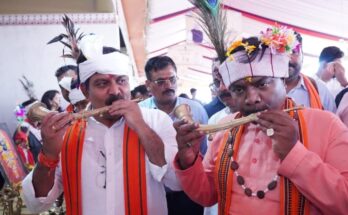Socially and culturally enriches Pola festival
A festival to honor the contribution of livestock in farming
- Manoj Singh, Assistant Director
Raipur, August 26, 2022
There has been a tradition of animal worship in Indian culture, its evidence is also found in the Indus civilization. Pola festival, which shows the importance of livestock in farming, is traditionally celebrated with enthusiasm in all the regions of Chhattisgarh. Evidence of the use of livestock in agriculture is found from ancient times. Pola is mainly a festival related to agriculture. In the month of Bhadon, this festival is celebrated on the new moon after the farming work is over. Since on this day the mother of food conceives, that is, milk fills the paddy plants on this day. That is why this festival is celebrated. Pola festival also holds special significance for women, men and children.
There is a belief behind the Pola festival that when Lord Vishnu came to the earth in the form of Kanha, which is celebrated as Krishna Janmashtami, his Kansa maternal uncle became the enemy of his life since birth, Kanha when he was young and Vasudeva. When Yashoda lived here, Kansa had sent many demons to kill him many times. Once Kansa had sent a demon named Polapur, this too was killed by Krishna because of his pastimes and everyone was taken by surprise. That day was the new moon day of the month of Bhadon. From this day it came to be called Pola, this day is called Children’s Day.
Before the Pola festival, there is a tradition in Chhattisgarh to bring married daughters from their in-laws to their maternal uncle. After Pola, daughters celebrate Teej. Keeping in view the social and cultural importance of the festival of Teej, Chief Minister Bhupesh Baghel has declared a general holiday. The Pola festival holds special significance for the farmers. Farmers consider the paddy crop as a symbol of Lakshmi on this day, wishing for a good and bountiful harvest. On this day, after bathing the bullocks by the farmers and worshiping them, they take a vow to get double zeal for agricultural work. After the worship of bulls, bull races are organized by farmers and cowherds. Even small children worship mud bullocks. where they get dakshina. Sports like Kabaddi, Fugdi, Kho-Kho, Pittul are organized in the villages. Children go from house to house carrying mud bullocks. This festival continues to inspire livestock promotion and conservation today.
Chhattisgarh is the highest cultivation of paddy, so rice and Chhattisgarhi dishes made from it are specially made here. On this day many other dishes such as typical, khurmi, bara, including cheela, airsa, sonhari, fara, murkhu, dehrauri, are prepared. These dishes are worshiped by filling them in earthen pots, toys, it is believed that the house should be full of wealth. On this day, girls also play a game of wearing earthen pots in their homes. It also gives an opportunity to understand social customs and mutual relationships and culture. Gedi procession is taken out in Chhattisgarh on this day. The gadi is made from bamboo, in which a long bamboo is crossed and a short bamboo is planted 1-2 feet above it. Then after balancing on it, he stands up and walks away.
There is a lot of sale of clay toys in the Pola festival. Traditionally working in the village, the people of handicrafts, carpenters and potters society start preparing for it much in advance. This festival also gives them employment, people use earthen utensils to deliver sweets to each other’s homes. There is also a tradition of changing Mitan in rural areas on this day. They go to each other’s homes for reconciliation. This festival also strengthens us socially and culturally.




